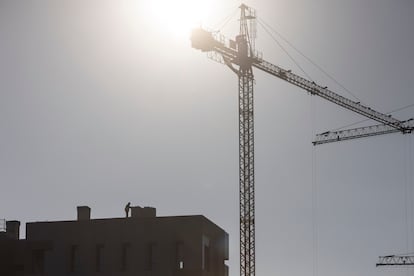Construction stagnates in areas with the greatest housing shortage


The main urban centres in Spain, which are also those with the greatest tension in the real estate market, are seeing their production of new construction stagnate or even fall. This is due to a disconnect between the supply of new properties and the areas with the highest demand, according to a report published this Tuesday by the appraisal company UVE Valoraciones . The study is based on official data on new construction starts (permits to build homes) from last November, the latest available, and compares them with the situation at the beginning of 2024. The figures confirm that although construction rose by 9% nationwide between March and November, the percentage is uneven between the provinces, and is even unfavourable for those with the most accentuated housing crisis . The case of Madrid, with a decrease of 1.47% in the number of new houses started, or Barcelona, where it barely grew by 1.95%. The appraiser contrasts this with the estimated deficit of 107,000 and 85,000 households, respectively, in both provinces.
Analysing trends in recent years, the researchers point out that Madrid started more than 20,000 homes per year in 2022, but this number decreased in 2023 and 2024, which means a cooling in production. Barcelona also reached its peak in 2022, standing “above pre-pandemic levels”, but “without sufficient reactivation”, the report clarifies.
The problem goes beyond the two most populated districts. In the Balearic Islands, one of the provinces with the greatest pressure from demand due to tourism and with the highest prices, the recent fall in construction reached 11.4%. The report highlights that it is the province with the greatest housing deficit in relation to its total stock. In a territory where almost 4,000 homes are sold per year to non-residents , the authors of the analysis add, “production is dangerously low.” In the Canary Islands, both in Las Palmas and Santa Cruz de Tenerife, the decline was even more pronounced, at more than 20%.
Seville, the only one that is savedAmong the most important provincial markets, Seville is the only one where the brick sector seems to be in very good health. Between March and November 2024, building permits increased by 30%. A behavior that, according to UVE Valoraciones, is not exclusive to this period. The report highlights that construction has increased steadily in that province since 2019, reaching levels three times higher than before the crisis caused by Covid. “This reaction is what should be replicated in provinces such as Madrid and Barcelona to mitigate the accumulated deficit of recent years,” warn the authors.
In Alicante, the province with the highest percentage of purchases by non-residents, the number of housing starts between March and November increased by 9%, a growth that the appraiser considers insufficient. And in Malaga - where a deficit of 15,000 homes is estimated and more than 10,500 are sold annually to non-residents - the variation was 6% and construction levels remain below those of 2019. The upturn was even shorter in Valencia (4%), where around 64,000 properties would be needed.
61% concentrated in ten provincesDespite marginal increases in some of the most stressed areas, these are still the territories where the most construction volume is being carried out. Specifically, if the provinces are ordered by the number of new construction projects they accumulated between November 2023 and the same month in 2024, the first ten account for six out of ten permits. They are Madrid, Barcelona, Seville, Malaga, Alicante, Valencia, Murcia, the Balearic Islands, Valladolid and Almeria.
However, the report concludes that despite this concentration, the areas where there is a lack of new construction to satisfy a growing demand “due to the creation of new families, the need to offset a deficit accumulated over the last few years or to meet the demand for purchases from non-residents” are not up to par. In this regard, Germán Pérez Barrio, president of UVE Valoraciones, points out that “the data show that construction continues to respond more to the availability of land and financing than to effective demand”. And this “is aggravating the shortage of properties in the main markets of Spain”, he concludes.
EL PAÍS






